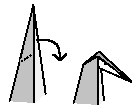(back to Origami Basics)
Extended Birdbase
Thanks to Joshua Koppel who is the designer of this base for letting me show the diagrams here. With the help of his base I was able to create some nice new models.
Start with a square sheet of paper.
 |
Valley Fold

The valley fold is formed by folding the paper toward oneself. An arrow shows where to fold the piece of paper to.
Symbol: dashed line
Mountain Fold

The mountain fold is formed by folding the paper away from oneself.
Symbol: alternating dashed and dotted line
 |
Valley Fold

The valley fold is formed by folding the paper toward oneself. An arrow shows where to fold the piece of paper to.
Symbol: dashed line
 |
Valley Fold

The valley fold is formed by folding the paper toward oneself. An arrow shows where to fold the piece of paper to.
Symbol: dashed line
 |
4. This is what you should get. Open up the model again.
 |
Valley Fold

The valley fold is formed by folding the paper toward oneself. An arrow shows where to fold the piece of paper to.
Symbol: dashed line
 |
Valley Fold

The valley fold is formed by folding the paper toward oneself. An arrow shows where to fold the piece of paper to.
Symbol: dashed line
 |
7. Repeat step 6 on the lower half.
 |
8. This is what you should get. Turn the model around.
 |
Valley Fold

The valley fold is formed by folding the paper toward oneself. An arrow shows where to fold the piece of paper to.
Symbol: dashed line
 |
10. Swing the flap over.
 |
Squash Fold

Prefold both sheets of paper along the valley and mountain fold. Then open the model, fold one layer of paper along the valley fold and flatten the model using the mountain fold.
The big white arrow tells you to open the model.
 |
12. Swing two flaps over.
 |
Squash Fold

Prefold both sheets of paper along the valley and mountain fold. Then open the model, fold one layer of paper along the valley fold and flatten the model using the mountain fold.
The big white arrow tells you to open the model.
 |
(Inside) Reverse Fold

Prefold both sheets of paper in both directions (mountain and valley). Then open the model a little bit and bring the top point down so that the mountain fold edge becomes a valley fold edge.
 |
15. Swing one flap over.
 |
(Inside) Reverse Fold

Prefold both sheets of paper in both directions (mountain and valley). Then open the model a little bit and bring the top point down so that the mountain fold edge becomes a valley fold edge.
 |
17. Swing the flap back and turn the model around.
 |
18. Swing one flap to the left.
 |
19. Repeat Steps 14-17 on this side.
 |
Squash Fold

Prefold both sheets of paper along the valley and mountain fold. Then open the model, fold one layer of paper along the valley fold and flatten the model using the mountain fold.
The big white arrow tells you to open the model.
 |
21. This is what you should get. Repeat Step 20 on the other three flaps.
 |
Petal Fold

The petal fold lifts a point and brings it upwards so that the two edges of the point lie together. It is best to prefold both layers of paper along the shown valley and mountain folds before making the petal fold.
 |
23. This is what you should get. Repeat Step 22 on the other three flaps.
 |
24. The finished extended birdbase. You should have the same number of flaps on both sides.
Starting from the extended birdbase you can create the following models:


